The Health belief and practices
VerifiedAdded on 2022/09/14
|10
|2853
|25
AI Summary
Contribute Materials
Your contribution can guide someone’s learning journey. Share your
documents today.

Running Head: HEALTH BELIEF AND PRACTICES 0
Health Beliefs and Practices
Student Details:
Health Beliefs and Practices
Student Details:
Secure Best Marks with AI Grader
Need help grading? Try our AI Grader for instant feedback on your assignments.
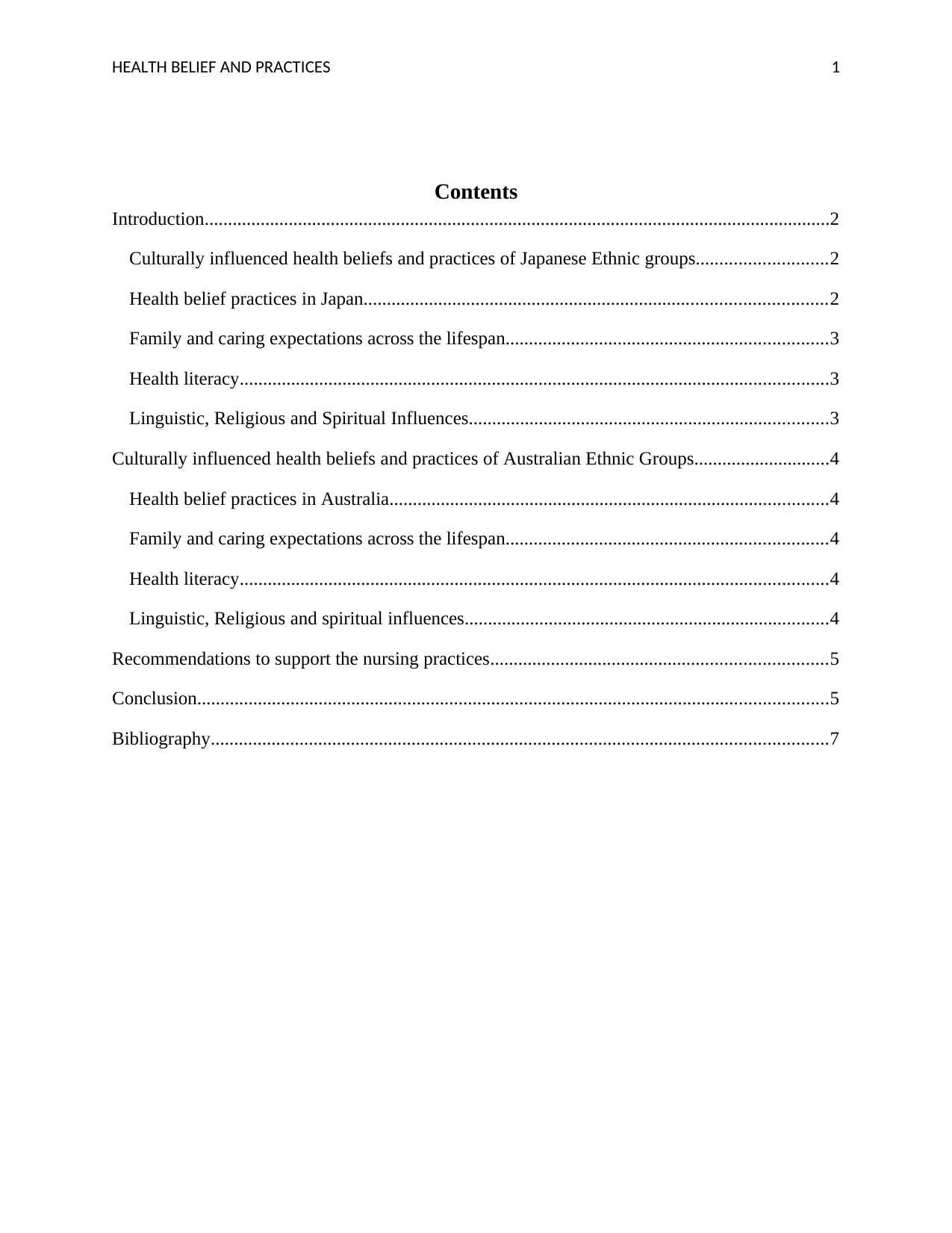
HEALTH BELIEF AND PRACTICES 1
Contents
Introduction......................................................................................................................................2
Culturally influenced health beliefs and practices of Japanese Ethnic groups............................2
Health belief practices in Japan...................................................................................................2
Family and caring expectations across the lifespan.....................................................................3
Health literacy..............................................................................................................................3
Linguistic, Religious and Spiritual Influences.............................................................................3
Culturally influenced health beliefs and practices of Australian Ethnic Groups.............................4
Health belief practices in Australia..............................................................................................4
Family and caring expectations across the lifespan.....................................................................4
Health literacy..............................................................................................................................4
Linguistic, Religious and spiritual influences..............................................................................4
Recommendations to support the nursing practices........................................................................5
Conclusion.......................................................................................................................................5
Bibliography....................................................................................................................................7
Contents
Introduction......................................................................................................................................2
Culturally influenced health beliefs and practices of Japanese Ethnic groups............................2
Health belief practices in Japan...................................................................................................2
Family and caring expectations across the lifespan.....................................................................3
Health literacy..............................................................................................................................3
Linguistic, Religious and Spiritual Influences.............................................................................3
Culturally influenced health beliefs and practices of Australian Ethnic Groups.............................4
Health belief practices in Australia..............................................................................................4
Family and caring expectations across the lifespan.....................................................................4
Health literacy..............................................................................................................................4
Linguistic, Religious and spiritual influences..............................................................................4
Recommendations to support the nursing practices........................................................................5
Conclusion.......................................................................................................................................5
Bibliography....................................................................................................................................7
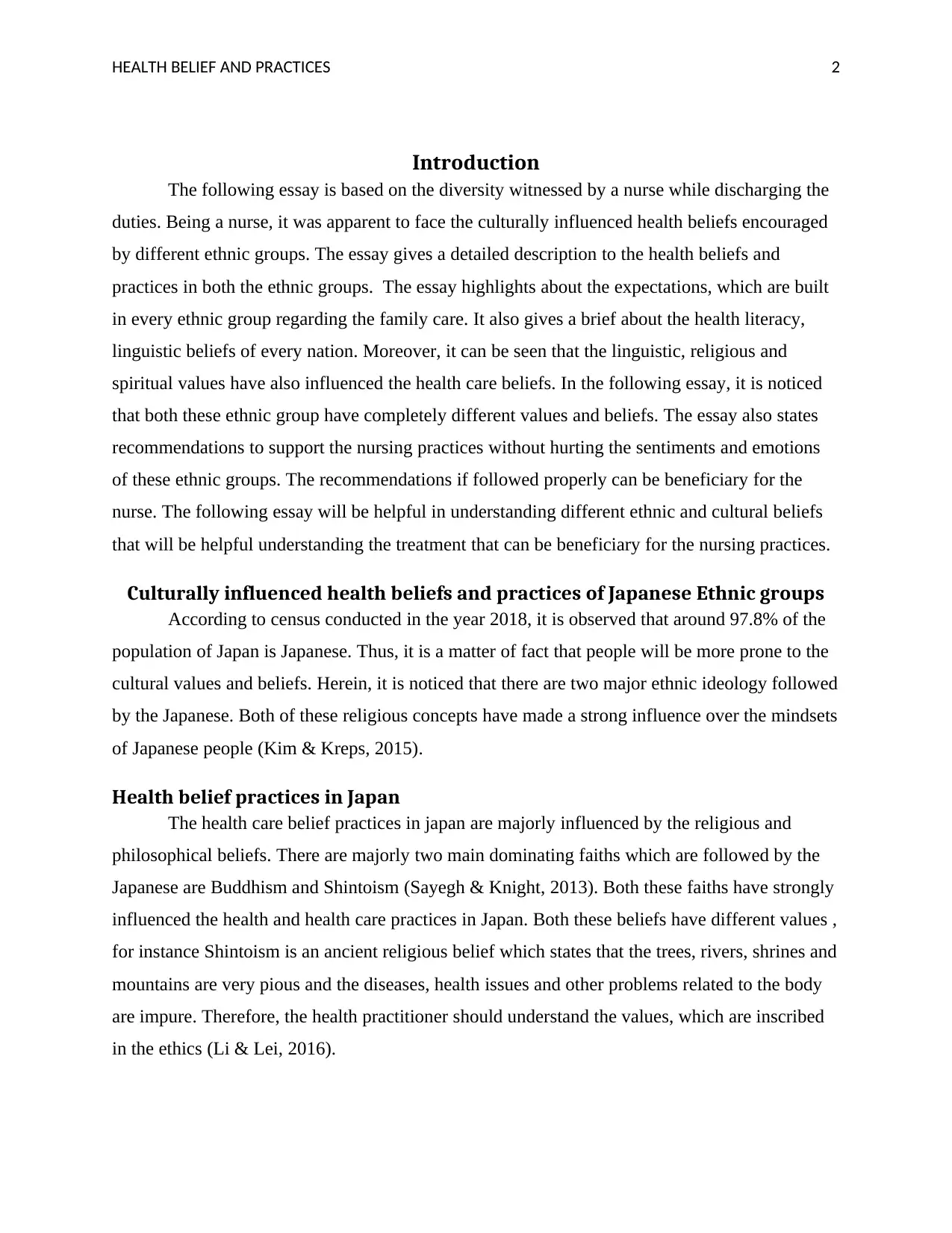
HEALTH BELIEF AND PRACTICES 2
Introduction
The following essay is based on the diversity witnessed by a nurse while discharging the
duties. Being a nurse, it was apparent to face the culturally influenced health beliefs encouraged
by different ethnic groups. The essay gives a detailed description to the health beliefs and
practices in both the ethnic groups. The essay highlights about the expectations, which are built
in every ethnic group regarding the family care. It also gives a brief about the health literacy,
linguistic beliefs of every nation. Moreover, it can be seen that the linguistic, religious and
spiritual values have also influenced the health care beliefs. In the following essay, it is noticed
that both these ethnic group have completely different values and beliefs. The essay also states
recommendations to support the nursing practices without hurting the sentiments and emotions
of these ethnic groups. The recommendations if followed properly can be beneficiary for the
nurse. The following essay will be helpful in understanding different ethnic and cultural beliefs
that will be helpful understanding the treatment that can be beneficiary for the nursing practices.
Culturally influenced health beliefs and practices of Japanese Ethnic groups
According to census conducted in the year 2018, it is observed that around 97.8% of the
population of Japan is Japanese. Thus, it is a matter of fact that people will be more prone to the
cultural values and beliefs. Herein, it is noticed that there are two major ethnic ideology followed
by the Japanese. Both of these religious concepts have made a strong influence over the mindsets
of Japanese people (Kim & Kreps, 2015).
Health belief practices in Japan
The health care belief practices in japan are majorly influenced by the religious and
philosophical beliefs. There are majorly two main dominating faiths which are followed by the
Japanese are Buddhism and Shintoism (Sayegh & Knight, 2013). Both these faiths have strongly
influenced the health and health care practices in Japan. Both these beliefs have different values ,
for instance Shintoism is an ancient religious belief which states that the trees, rivers, shrines and
mountains are very pious and the diseases, health issues and other problems related to the body
are impure. Therefore, the health practitioner should understand the values, which are inscribed
in the ethics (Li & Lei, 2016).
Introduction
The following essay is based on the diversity witnessed by a nurse while discharging the
duties. Being a nurse, it was apparent to face the culturally influenced health beliefs encouraged
by different ethnic groups. The essay gives a detailed description to the health beliefs and
practices in both the ethnic groups. The essay highlights about the expectations, which are built
in every ethnic group regarding the family care. It also gives a brief about the health literacy,
linguistic beliefs of every nation. Moreover, it can be seen that the linguistic, religious and
spiritual values have also influenced the health care beliefs. In the following essay, it is noticed
that both these ethnic group have completely different values and beliefs. The essay also states
recommendations to support the nursing practices without hurting the sentiments and emotions
of these ethnic groups. The recommendations if followed properly can be beneficiary for the
nurse. The following essay will be helpful in understanding different ethnic and cultural beliefs
that will be helpful understanding the treatment that can be beneficiary for the nursing practices.
Culturally influenced health beliefs and practices of Japanese Ethnic groups
According to census conducted in the year 2018, it is observed that around 97.8% of the
population of Japan is Japanese. Thus, it is a matter of fact that people will be more prone to the
cultural values and beliefs. Herein, it is noticed that there are two major ethnic ideology followed
by the Japanese. Both of these religious concepts have made a strong influence over the mindsets
of Japanese people (Kim & Kreps, 2015).
Health belief practices in Japan
The health care belief practices in japan are majorly influenced by the religious and
philosophical beliefs. There are majorly two main dominating faiths which are followed by the
Japanese are Buddhism and Shintoism (Sayegh & Knight, 2013). Both these faiths have strongly
influenced the health and health care practices in Japan. Both these beliefs have different values ,
for instance Shintoism is an ancient religious belief which states that the trees, rivers, shrines and
mountains are very pious and the diseases, health issues and other problems related to the body
are impure. Therefore, the health practitioner should understand the values, which are inscribed
in the ethics (Li & Lei, 2016).
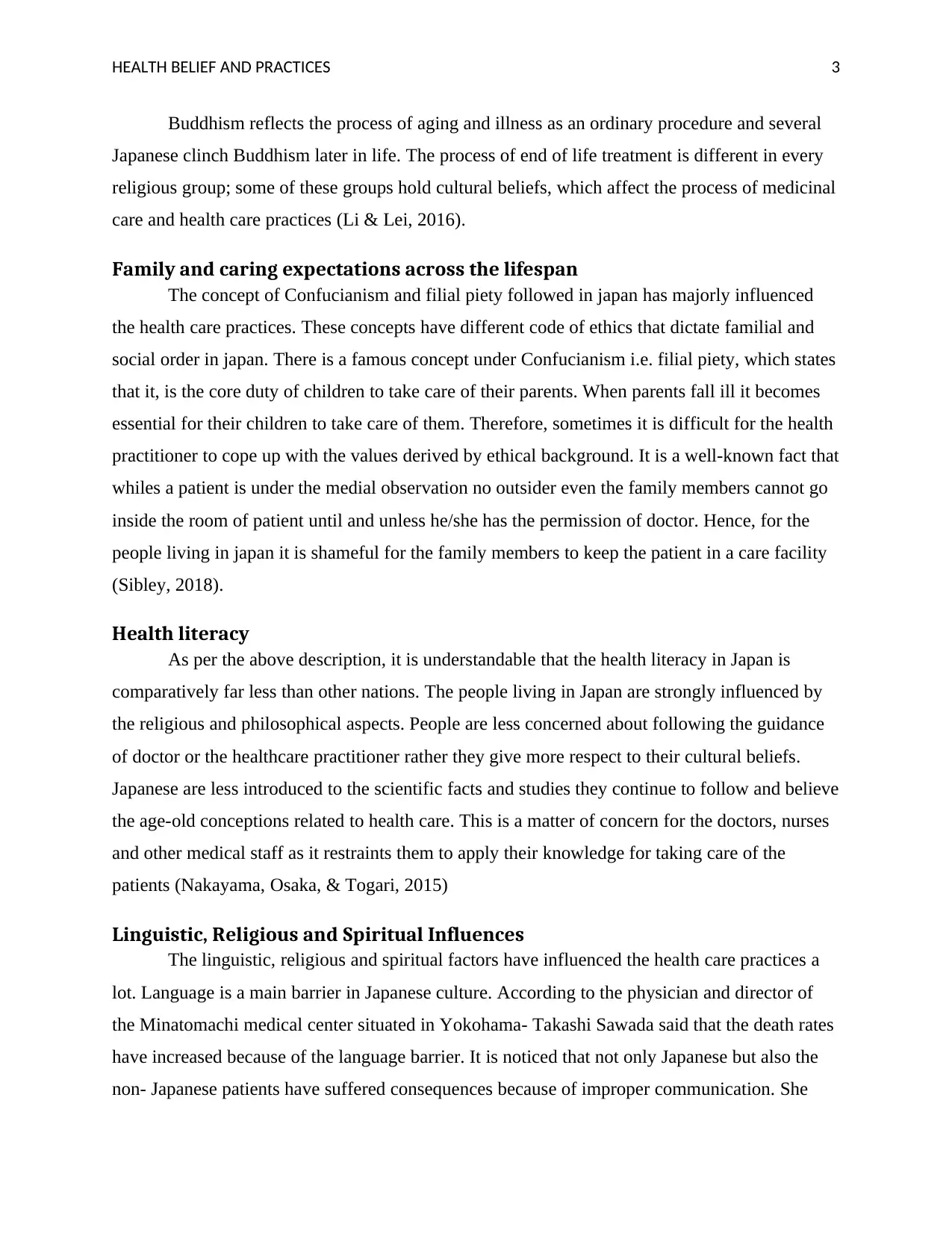
HEALTH BELIEF AND PRACTICES 3
Buddhism reflects the process of aging and illness as an ordinary procedure and several
Japanese clinch Buddhism later in life. The process of end of life treatment is different in every
religious group; some of these groups hold cultural beliefs, which affect the process of medicinal
care and health care practices (Li & Lei, 2016).
Family and caring expectations across the lifespan
The concept of Confucianism and filial piety followed in japan has majorly influenced
the health care practices. These concepts have different code of ethics that dictate familial and
social order in japan. There is a famous concept under Confucianism i.e. filial piety, which states
that it, is the core duty of children to take care of their parents. When parents fall ill it becomes
essential for their children to take care of them. Therefore, sometimes it is difficult for the health
practitioner to cope up with the values derived by ethical background. It is a well-known fact that
whiles a patient is under the medial observation no outsider even the family members cannot go
inside the room of patient until and unless he/she has the permission of doctor. Hence, for the
people living in japan it is shameful for the family members to keep the patient in a care facility
(Sibley, 2018).
Health literacy
As per the above description, it is understandable that the health literacy in Japan is
comparatively far less than other nations. The people living in Japan are strongly influenced by
the religious and philosophical aspects. People are less concerned about following the guidance
of doctor or the healthcare practitioner rather they give more respect to their cultural beliefs.
Japanese are less introduced to the scientific facts and studies they continue to follow and believe
the age-old conceptions related to health care. This is a matter of concern for the doctors, nurses
and other medical staff as it restraints them to apply their knowledge for taking care of the
patients (Nakayama, Osaka, & Togari, 2015)
Linguistic, Religious and Spiritual Influences
The linguistic, religious and spiritual factors have influenced the health care practices a
lot. Language is a main barrier in Japanese culture. According to the physician and director of
the Minatomachi medical center situated in Yokohama- Takashi Sawada said that the death rates
have increased because of the language barrier. It is noticed that not only Japanese but also the
non- Japanese patients have suffered consequences because of improper communication. She
Buddhism reflects the process of aging and illness as an ordinary procedure and several
Japanese clinch Buddhism later in life. The process of end of life treatment is different in every
religious group; some of these groups hold cultural beliefs, which affect the process of medicinal
care and health care practices (Li & Lei, 2016).
Family and caring expectations across the lifespan
The concept of Confucianism and filial piety followed in japan has majorly influenced
the health care practices. These concepts have different code of ethics that dictate familial and
social order in japan. There is a famous concept under Confucianism i.e. filial piety, which states
that it, is the core duty of children to take care of their parents. When parents fall ill it becomes
essential for their children to take care of them. Therefore, sometimes it is difficult for the health
practitioner to cope up with the values derived by ethical background. It is a well-known fact that
whiles a patient is under the medial observation no outsider even the family members cannot go
inside the room of patient until and unless he/she has the permission of doctor. Hence, for the
people living in japan it is shameful for the family members to keep the patient in a care facility
(Sibley, 2018).
Health literacy
As per the above description, it is understandable that the health literacy in Japan is
comparatively far less than other nations. The people living in Japan are strongly influenced by
the religious and philosophical aspects. People are less concerned about following the guidance
of doctor or the healthcare practitioner rather they give more respect to their cultural beliefs.
Japanese are less introduced to the scientific facts and studies they continue to follow and believe
the age-old conceptions related to health care. This is a matter of concern for the doctors, nurses
and other medical staff as it restraints them to apply their knowledge for taking care of the
patients (Nakayama, Osaka, & Togari, 2015)
Linguistic, Religious and Spiritual Influences
The linguistic, religious and spiritual factors have influenced the health care practices a
lot. Language is a main barrier in Japanese culture. According to the physician and director of
the Minatomachi medical center situated in Yokohama- Takashi Sawada said that the death rates
have increased because of the language barrier. It is noticed that not only Japanese but also the
non- Japanese patients have suffered consequences because of improper communication. She
Secure Best Marks with AI Grader
Need help grading? Try our AI Grader for instant feedback on your assignments.
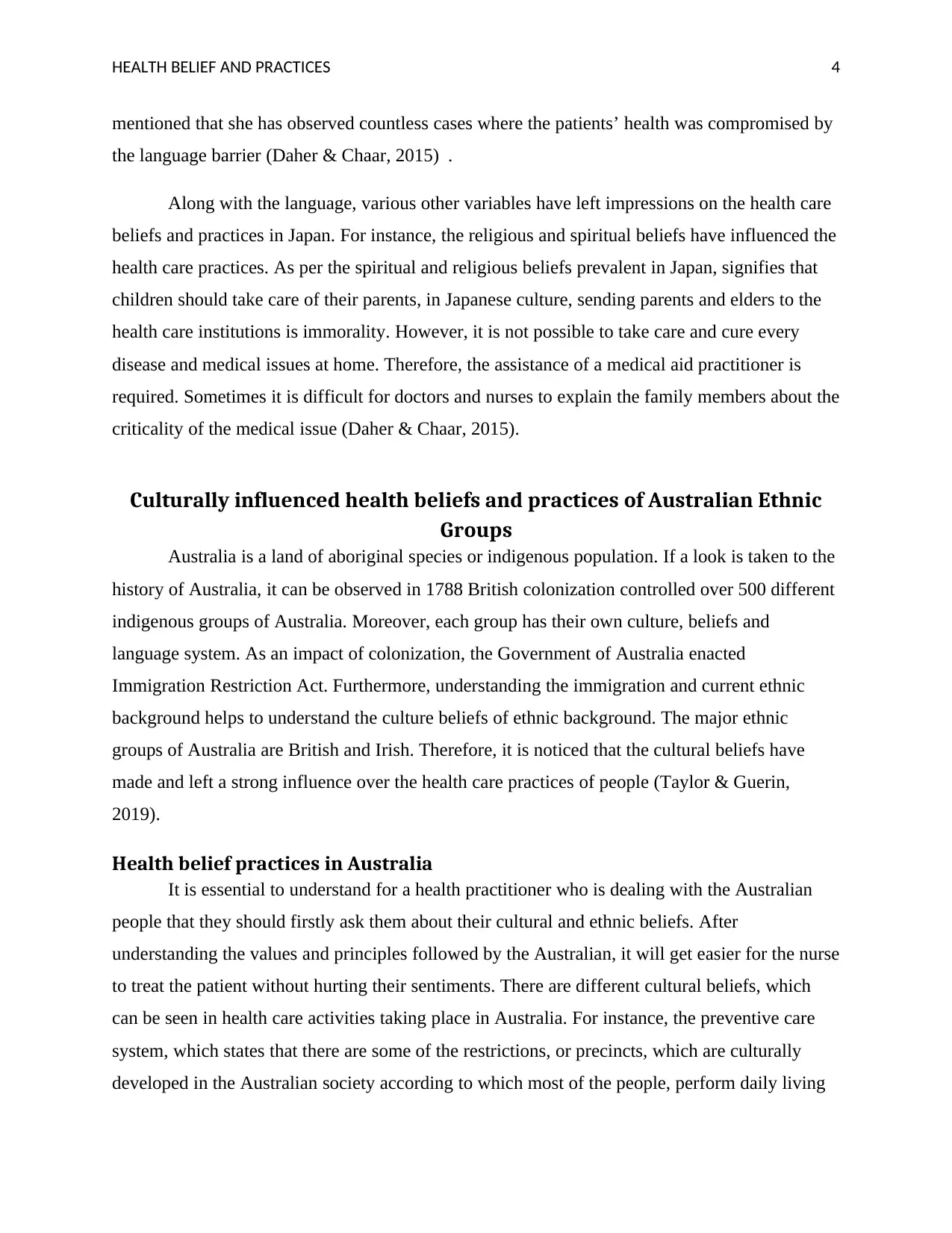
HEALTH BELIEF AND PRACTICES 4
mentioned that she has observed countless cases where the patients’ health was compromised by
the language barrier (Daher & Chaar, 2015) .
Along with the language, various other variables have left impressions on the health care
beliefs and practices in Japan. For instance, the religious and spiritual beliefs have influenced the
health care practices. As per the spiritual and religious beliefs prevalent in Japan, signifies that
children should take care of their parents, in Japanese culture, sending parents and elders to the
health care institutions is immorality. However, it is not possible to take care and cure every
disease and medical issues at home. Therefore, the assistance of a medical aid practitioner is
required. Sometimes it is difficult for doctors and nurses to explain the family members about the
criticality of the medical issue (Daher & Chaar, 2015).
Culturally influenced health beliefs and practices of Australian Ethnic
Groups
Australia is a land of aboriginal species or indigenous population. If a look is taken to the
history of Australia, it can be observed in 1788 British colonization controlled over 500 different
indigenous groups of Australia. Moreover, each group has their own culture, beliefs and
language system. As an impact of colonization, the Government of Australia enacted
Immigration Restriction Act. Furthermore, understanding the immigration and current ethnic
background helps to understand the culture beliefs of ethnic background. The major ethnic
groups of Australia are British and Irish. Therefore, it is noticed that the cultural beliefs have
made and left a strong influence over the health care practices of people (Taylor & Guerin,
2019).
Health belief practices in Australia
It is essential to understand for a health practitioner who is dealing with the Australian
people that they should firstly ask them about their cultural and ethnic beliefs. After
understanding the values and principles followed by the Australian, it will get easier for the nurse
to treat the patient without hurting their sentiments. There are different cultural beliefs, which
can be seen in health care activities taking place in Australia. For instance, the preventive care
system, which states that there are some of the restrictions, or precincts, which are culturally
developed in the Australian society according to which most of the people, perform daily living
mentioned that she has observed countless cases where the patients’ health was compromised by
the language barrier (Daher & Chaar, 2015) .
Along with the language, various other variables have left impressions on the health care
beliefs and practices in Japan. For instance, the religious and spiritual beliefs have influenced the
health care practices. As per the spiritual and religious beliefs prevalent in Japan, signifies that
children should take care of their parents, in Japanese culture, sending parents and elders to the
health care institutions is immorality. However, it is not possible to take care and cure every
disease and medical issues at home. Therefore, the assistance of a medical aid practitioner is
required. Sometimes it is difficult for doctors and nurses to explain the family members about the
criticality of the medical issue (Daher & Chaar, 2015).
Culturally influenced health beliefs and practices of Australian Ethnic
Groups
Australia is a land of aboriginal species or indigenous population. If a look is taken to the
history of Australia, it can be observed in 1788 British colonization controlled over 500 different
indigenous groups of Australia. Moreover, each group has their own culture, beliefs and
language system. As an impact of colonization, the Government of Australia enacted
Immigration Restriction Act. Furthermore, understanding the immigration and current ethnic
background helps to understand the culture beliefs of ethnic background. The major ethnic
groups of Australia are British and Irish. Therefore, it is noticed that the cultural beliefs have
made and left a strong influence over the health care practices of people (Taylor & Guerin,
2019).
Health belief practices in Australia
It is essential to understand for a health practitioner who is dealing with the Australian
people that they should firstly ask them about their cultural and ethnic beliefs. After
understanding the values and principles followed by the Australian, it will get easier for the nurse
to treat the patient without hurting their sentiments. There are different cultural beliefs, which
can be seen in health care activities taking place in Australia. For instance, the preventive care
system, which states that there are some of the restrictions, or precincts, which are culturally
developed in the Australian society according to which most of the people, perform daily living
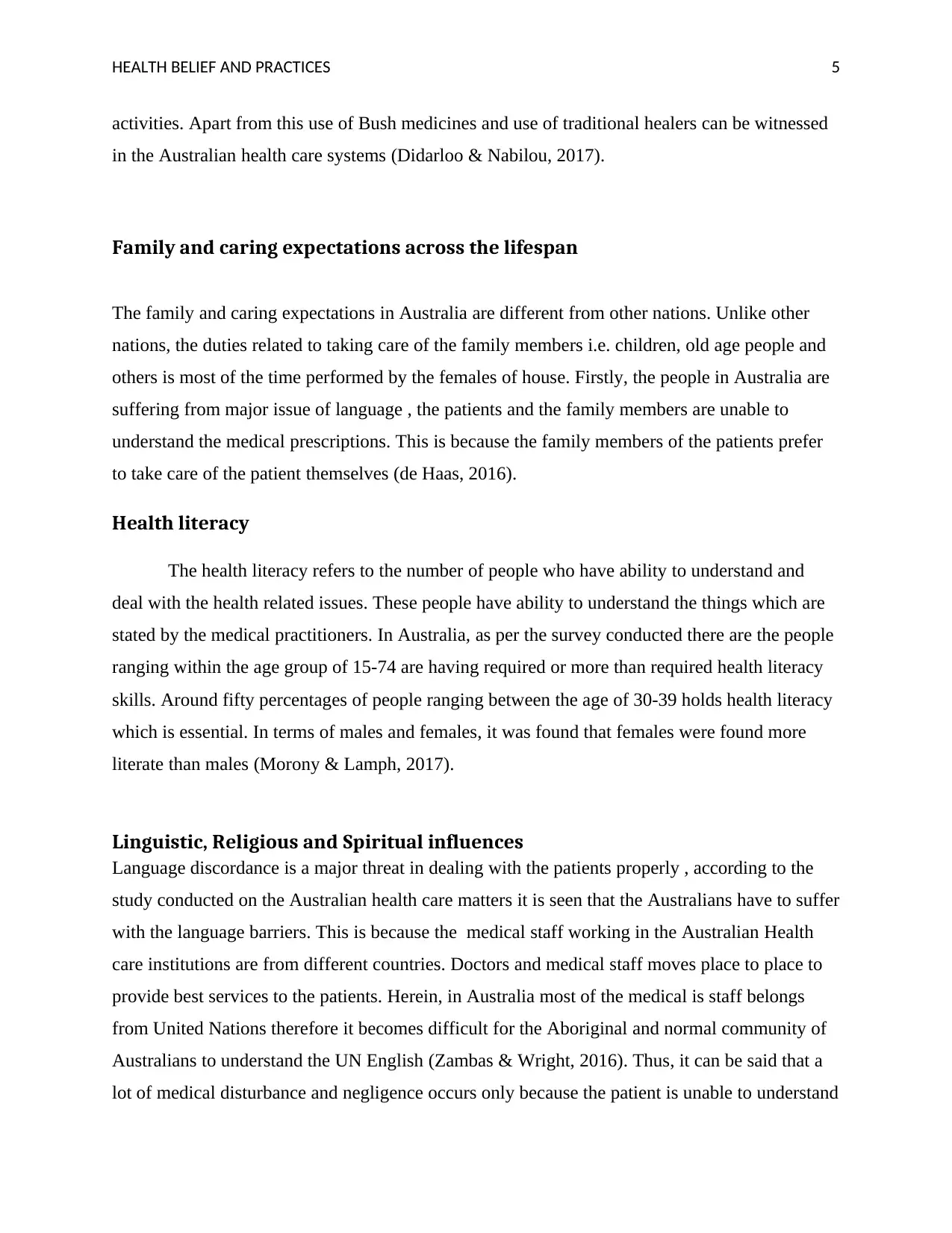
HEALTH BELIEF AND PRACTICES 5
activities. Apart from this use of Bush medicines and use of traditional healers can be witnessed
in the Australian health care systems (Didarloo & Nabilou, 2017).
Family and caring expectations across the lifespan
The family and caring expectations in Australia are different from other nations. Unlike other
nations, the duties related to taking care of the family members i.e. children, old age people and
others is most of the time performed by the females of house. Firstly, the people in Australia are
suffering from major issue of language , the patients and the family members are unable to
understand the medical prescriptions. This is because the family members of the patients prefer
to take care of the patient themselves (de Haas, 2016).
Health literacy
The health literacy refers to the number of people who have ability to understand and
deal with the health related issues. These people have ability to understand the things which are
stated by the medical practitioners. In Australia, as per the survey conducted there are the people
ranging within the age group of 15-74 are having required or more than required health literacy
skills. Around fifty percentages of people ranging between the age of 30-39 holds health literacy
which is essential. In terms of males and females, it was found that females were found more
literate than males (Morony & Lamph, 2017).
Linguistic, Religious and Spiritual influences
Language discordance is a major threat in dealing with the patients properly , according to the
study conducted on the Australian health care matters it is seen that the Australians have to suffer
with the language barriers. This is because the medical staff working in the Australian Health
care institutions are from different countries. Doctors and medical staff moves place to place to
provide best services to the patients. Herein, in Australia most of the medical is staff belongs
from United Nations therefore it becomes difficult for the Aboriginal and normal community of
Australians to understand the UN English (Zambas & Wright, 2016). Thus, it can be said that a
lot of medical disturbance and negligence occurs only because the patient is unable to understand
activities. Apart from this use of Bush medicines and use of traditional healers can be witnessed
in the Australian health care systems (Didarloo & Nabilou, 2017).
Family and caring expectations across the lifespan
The family and caring expectations in Australia are different from other nations. Unlike other
nations, the duties related to taking care of the family members i.e. children, old age people and
others is most of the time performed by the females of house. Firstly, the people in Australia are
suffering from major issue of language , the patients and the family members are unable to
understand the medical prescriptions. This is because the family members of the patients prefer
to take care of the patient themselves (de Haas, 2016).
Health literacy
The health literacy refers to the number of people who have ability to understand and
deal with the health related issues. These people have ability to understand the things which are
stated by the medical practitioners. In Australia, as per the survey conducted there are the people
ranging within the age group of 15-74 are having required or more than required health literacy
skills. Around fifty percentages of people ranging between the age of 30-39 holds health literacy
which is essential. In terms of males and females, it was found that females were found more
literate than males (Morony & Lamph, 2017).
Linguistic, Religious and Spiritual influences
Language discordance is a major threat in dealing with the patients properly , according to the
study conducted on the Australian health care matters it is seen that the Australians have to suffer
with the language barriers. This is because the medical staff working in the Australian Health
care institutions are from different countries. Doctors and medical staff moves place to place to
provide best services to the patients. Herein, in Australia most of the medical is staff belongs
from United Nations therefore it becomes difficult for the Aboriginal and normal community of
Australians to understand the UN English (Zambas & Wright, 2016). Thus, it can be said that a
lot of medical disturbance and negligence occurs only because the patient is unable to understand
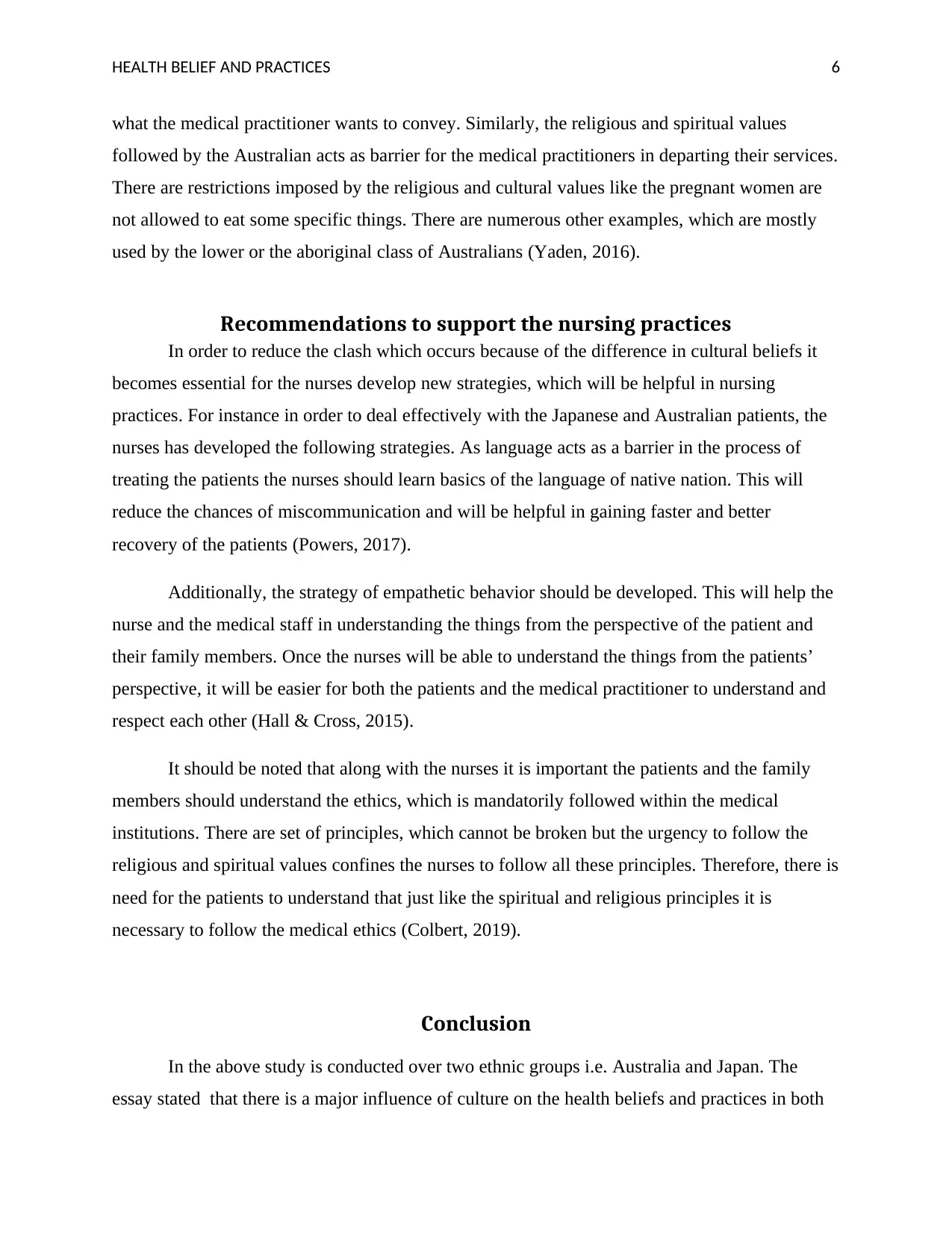
HEALTH BELIEF AND PRACTICES 6
what the medical practitioner wants to convey. Similarly, the religious and spiritual values
followed by the Australian acts as barrier for the medical practitioners in departing their services.
There are restrictions imposed by the religious and cultural values like the pregnant women are
not allowed to eat some specific things. There are numerous other examples, which are mostly
used by the lower or the aboriginal class of Australians (Yaden, 2016).
Recommendations to support the nursing practices
In order to reduce the clash which occurs because of the difference in cultural beliefs it
becomes essential for the nurses develop new strategies, which will be helpful in nursing
practices. For instance in order to deal effectively with the Japanese and Australian patients, the
nurses has developed the following strategies. As language acts as a barrier in the process of
treating the patients the nurses should learn basics of the language of native nation. This will
reduce the chances of miscommunication and will be helpful in gaining faster and better
recovery of the patients (Powers, 2017).
Additionally, the strategy of empathetic behavior should be developed. This will help the
nurse and the medical staff in understanding the things from the perspective of the patient and
their family members. Once the nurses will be able to understand the things from the patients’
perspective, it will be easier for both the patients and the medical practitioner to understand and
respect each other (Hall & Cross, 2015).
It should be noted that along with the nurses it is important the patients and the family
members should understand the ethics, which is mandatorily followed within the medical
institutions. There are set of principles, which cannot be broken but the urgency to follow the
religious and spiritual values confines the nurses to follow all these principles. Therefore, there is
need for the patients to understand that just like the spiritual and religious principles it is
necessary to follow the medical ethics (Colbert, 2019).
Conclusion
In the above study is conducted over two ethnic groups i.e. Australia and Japan. The
essay stated that there is a major influence of culture on the health beliefs and practices in both
what the medical practitioner wants to convey. Similarly, the religious and spiritual values
followed by the Australian acts as barrier for the medical practitioners in departing their services.
There are restrictions imposed by the religious and cultural values like the pregnant women are
not allowed to eat some specific things. There are numerous other examples, which are mostly
used by the lower or the aboriginal class of Australians (Yaden, 2016).
Recommendations to support the nursing practices
In order to reduce the clash which occurs because of the difference in cultural beliefs it
becomes essential for the nurses develop new strategies, which will be helpful in nursing
practices. For instance in order to deal effectively with the Japanese and Australian patients, the
nurses has developed the following strategies. As language acts as a barrier in the process of
treating the patients the nurses should learn basics of the language of native nation. This will
reduce the chances of miscommunication and will be helpful in gaining faster and better
recovery of the patients (Powers, 2017).
Additionally, the strategy of empathetic behavior should be developed. This will help the
nurse and the medical staff in understanding the things from the perspective of the patient and
their family members. Once the nurses will be able to understand the things from the patients’
perspective, it will be easier for both the patients and the medical practitioner to understand and
respect each other (Hall & Cross, 2015).
It should be noted that along with the nurses it is important the patients and the family
members should understand the ethics, which is mandatorily followed within the medical
institutions. There are set of principles, which cannot be broken but the urgency to follow the
religious and spiritual values confines the nurses to follow all these principles. Therefore, there is
need for the patients to understand that just like the spiritual and religious principles it is
necessary to follow the medical ethics (Colbert, 2019).
Conclusion
In the above study is conducted over two ethnic groups i.e. Australia and Japan. The
essay stated that there is a major influence of culture on the health beliefs and practices in both
Paraphrase This Document
Need a fresh take? Get an instant paraphrase of this document with our AI Paraphraser
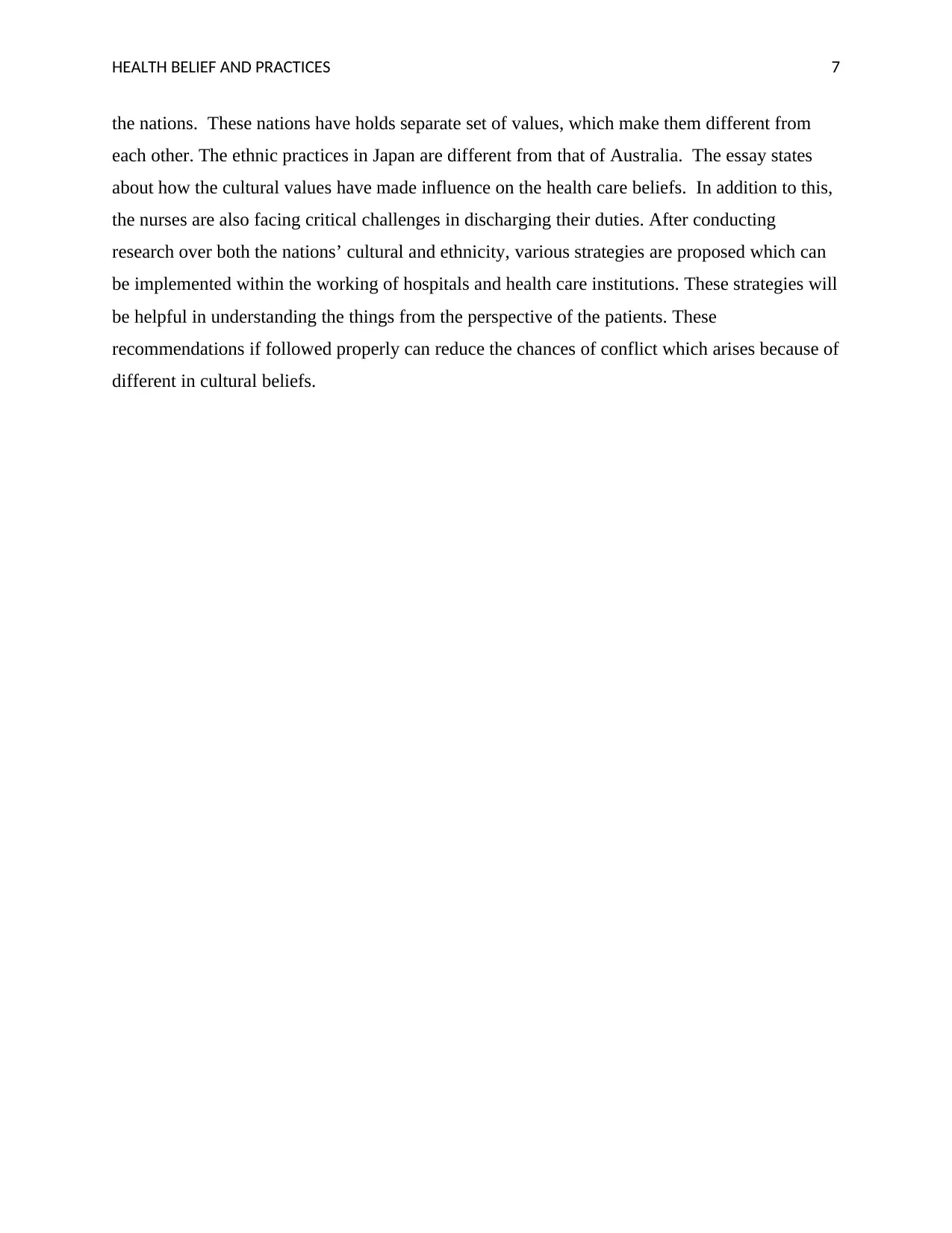
HEALTH BELIEF AND PRACTICES 7
the nations. These nations have holds separate set of values, which make them different from
each other. The ethnic practices in Japan are different from that of Australia. The essay states
about how the cultural values have made influence on the health care beliefs. In addition to this,
the nurses are also facing critical challenges in discharging their duties. After conducting
research over both the nations’ cultural and ethnicity, various strategies are proposed which can
be implemented within the working of hospitals and health care institutions. These strategies will
be helpful in understanding the things from the perspective of the patients. These
recommendations if followed properly can reduce the chances of conflict which arises because of
different in cultural beliefs.
the nations. These nations have holds separate set of values, which make them different from
each other. The ethnic practices in Japan are different from that of Australia. The essay states
about how the cultural values have made influence on the health care beliefs. In addition to this,
the nurses are also facing critical challenges in discharging their duties. After conducting
research over both the nations’ cultural and ethnicity, various strategies are proposed which can
be implemented within the working of hospitals and health care institutions. These strategies will
be helpful in understanding the things from the perspective of the patients. These
recommendations if followed properly can reduce the chances of conflict which arises because of
different in cultural beliefs.
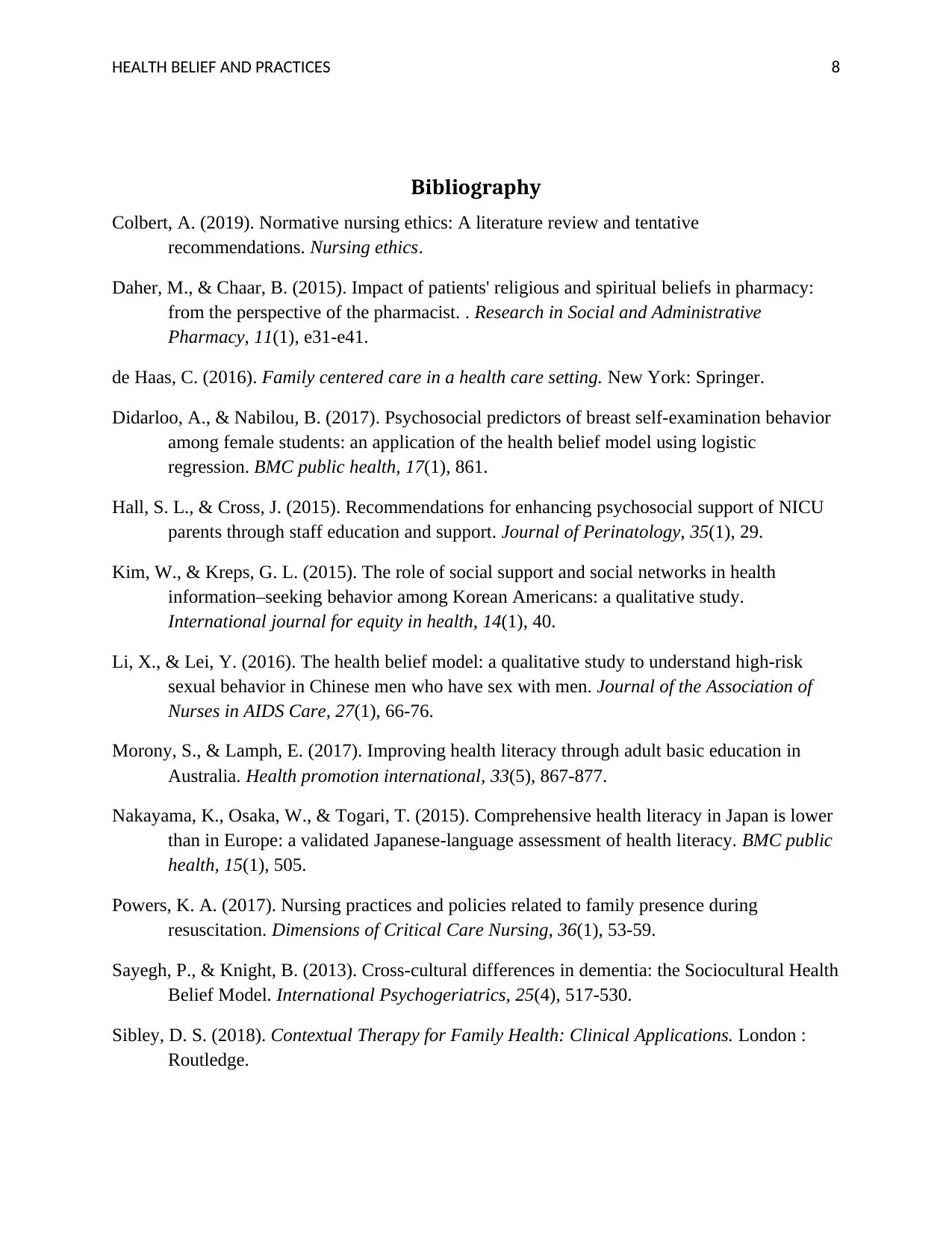
HEALTH BELIEF AND PRACTICES 8
Bibliography
Colbert, A. (2019). Normative nursing ethics: A literature review and tentative
recommendations. Nursing ethics.
Daher, M., & Chaar, B. (2015). Impact of patients' religious and spiritual beliefs in pharmacy:
from the perspective of the pharmacist. . Research in Social and Administrative
Pharmacy, 11(1), e31-e41.
de Haas, C. (2016). Family centered care in a health care setting. New York: Springer.
Didarloo, A., & Nabilou, B. (2017). Psychosocial predictors of breast self-examination behavior
among female students: an application of the health belief model using logistic
regression. BMC public health, 17(1), 861.
Hall, S. L., & Cross, J. (2015). Recommendations for enhancing psychosocial support of NICU
parents through staff education and support. Journal of Perinatology, 35(1), 29.
Kim, W., & Kreps, G. L. (2015). The role of social support and social networks in health
information–seeking behavior among Korean Americans: a qualitative study.
International journal for equity in health, 14(1), 40.
Li, X., & Lei, Y. (2016). The health belief model: a qualitative study to understand high-risk
sexual behavior in Chinese men who have sex with men. Journal of the Association of
Nurses in AIDS Care, 27(1), 66-76.
Morony, S., & Lamph, E. (2017). Improving health literacy through adult basic education in
Australia. Health promotion international, 33(5), 867-877.
Nakayama, K., Osaka, W., & Togari, T. (2015). Comprehensive health literacy in Japan is lower
than in Europe: a validated Japanese-language assessment of health literacy. BMC public
health, 15(1), 505.
Powers, K. A. (2017). Nursing practices and policies related to family presence during
resuscitation. Dimensions of Critical Care Nursing, 36(1), 53-59.
Sayegh, P., & Knight, B. (2013). Cross-cultural differences in dementia: the Sociocultural Health
Belief Model. International Psychogeriatrics, 25(4), 517-530.
Sibley, D. S. (2018). Contextual Therapy for Family Health: Clinical Applications. London :
Routledge.
Bibliography
Colbert, A. (2019). Normative nursing ethics: A literature review and tentative
recommendations. Nursing ethics.
Daher, M., & Chaar, B. (2015). Impact of patients' religious and spiritual beliefs in pharmacy:
from the perspective of the pharmacist. . Research in Social and Administrative
Pharmacy, 11(1), e31-e41.
de Haas, C. (2016). Family centered care in a health care setting. New York: Springer.
Didarloo, A., & Nabilou, B. (2017). Psychosocial predictors of breast self-examination behavior
among female students: an application of the health belief model using logistic
regression. BMC public health, 17(1), 861.
Hall, S. L., & Cross, J. (2015). Recommendations for enhancing psychosocial support of NICU
parents through staff education and support. Journal of Perinatology, 35(1), 29.
Kim, W., & Kreps, G. L. (2015). The role of social support and social networks in health
information–seeking behavior among Korean Americans: a qualitative study.
International journal for equity in health, 14(1), 40.
Li, X., & Lei, Y. (2016). The health belief model: a qualitative study to understand high-risk
sexual behavior in Chinese men who have sex with men. Journal of the Association of
Nurses in AIDS Care, 27(1), 66-76.
Morony, S., & Lamph, E. (2017). Improving health literacy through adult basic education in
Australia. Health promotion international, 33(5), 867-877.
Nakayama, K., Osaka, W., & Togari, T. (2015). Comprehensive health literacy in Japan is lower
than in Europe: a validated Japanese-language assessment of health literacy. BMC public
health, 15(1), 505.
Powers, K. A. (2017). Nursing practices and policies related to family presence during
resuscitation. Dimensions of Critical Care Nursing, 36(1), 53-59.
Sayegh, P., & Knight, B. (2013). Cross-cultural differences in dementia: the Sociocultural Health
Belief Model. International Psychogeriatrics, 25(4), 517-530.
Sibley, D. S. (2018). Contextual Therapy for Family Health: Clinical Applications. London :
Routledge.

HEALTH BELIEF AND PRACTICES 9
Taylor, K., & Guerin, P. (2019). Health care and Indigenous Australians: cultural safety in
practice. London: Macmillan International Higher Education.
Yaden, D. B. (2016). The language of ineffability: Linguistic analysis of mystical experiences. .
Psychology of Religion and Spirituality, 8(3), 244.
Zambas, S., & Wright, J. (2016). Impact of colonialism on Māori and Aboriginal healthcare
access: a discussion paper. Contemporary nurse, 52(4), 398-409.
Taylor, K., & Guerin, P. (2019). Health care and Indigenous Australians: cultural safety in
practice. London: Macmillan International Higher Education.
Yaden, D. B. (2016). The language of ineffability: Linguistic analysis of mystical experiences. .
Psychology of Religion and Spirituality, 8(3), 244.
Zambas, S., & Wright, J. (2016). Impact of colonialism on Māori and Aboriginal healthcare
access: a discussion paper. Contemporary nurse, 52(4), 398-409.
1 out of 10
Related Documents
Your All-in-One AI-Powered Toolkit for Academic Success.
+13062052269
info@desklib.com
Available 24*7 on WhatsApp / Email
![[object Object]](/_next/static/media/star-bottom.7253800d.svg)
Unlock your academic potential
© 2024 | Zucol Services PVT LTD | All rights reserved.





